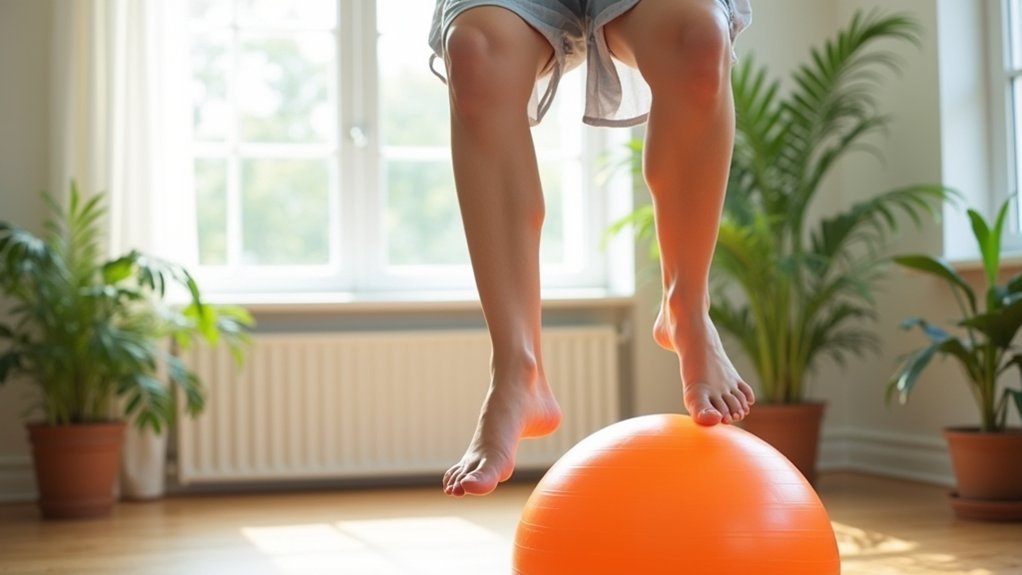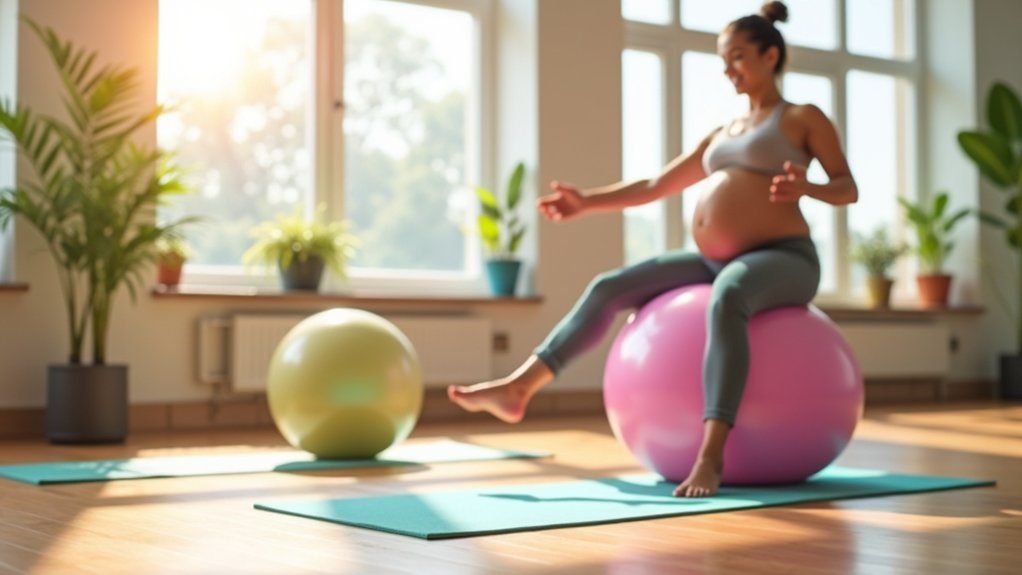During pregnancy, keep your bounce height conservative: 1-2 inches in the first trimester, 2-3 inches in the second, and back to 1-2 inches in the third trimester. Always use a properly sized ball (55-75cm based on your height) that allows for a 90° knee bend. Maintain an engaged core, upright posture, and limit sessions to 10-30 minutes. Stop immediately if you experience discomfort. The right technique can transform your pregnancy exercise routine.
Optimal Low-Impact Bounce Ranges for First Trimester

While adjusting to the early stages of pregnancy, you’ll want to guarantee your exercise routine remains safe and effective. During your first trimester, keep bouncing movements gentle and controlled with minimal amplitude to reduce strain.
When using a pregnancy ball, position yourself so your knees and hips remain at or slightly below a 90-degree angle. This stable positioning maximizes benefits while minimizing risk.
The elevated relaxin levels in early pregnancy actually make gentle bouncing particularly beneficial for joint mobility and muscle relaxation. Incorporating these gentle movements can help prepare your body for an uncomplicated birth later on.
Make sure your ball is properly inflated to support your changing body. Your bounces should focus on smooth, low movements rather than high-impact jumps.
If you experience any discomfort, stop immediately and consult your healthcare provider before continuing with bounce exercises.
Moderate Bounce Heights for Second Trimester Balance
As your pregnancy progresses into the second trimester, your changing center of gravity requires adjustments to exercise routines for maintaining balance and stability.
You’ll now benefit from gentle, consistent bouncing that enhances your pelvic alignment while supporting your growing baby.
When using your exercise ball, make sure it’s properly inflated and sized for your height—65cm if you’re under 1.73m tall.
Position yourself so your hips and knees form a 90-degree angle or with knees slightly lower than hips for best support.
Regular bouncing sessions strengthen pelvic muscles, reduce lower back strain, and help guide your baby into proper position.
Keep sessions under 30 minutes, incorporating pelvic tilts and breathing techniques.
Always monitor your comfort level and consult your healthcare provider about your exercise routine.
For optimal safety and stability during exercise, choose a birthing ball made with anti-burst material that will slowly deflate rather than suddenly pop if punctured.
Gentler Third Trimester Bouncing Techniques

The third trimester introduces unique physical demands requiring gentler exercise approaches than earlier pregnancy stages.
During this final stretch, limit your bounces to just 1-3 inches in height, focusing on controlled rhythm rather than speed or intensity.
Prioritize 10-20 minute daily sessions on an anti-burst ball that positions your knees at 90° when seated.
Maintain proper posture with an upright spine and engaged core to protect your lower back.
These low-impact movements support pelvic alignment while encouraging ideal fetal positioning. These gentle bounces help release tension through the pelvic floor as you maintain consistent breathing patterns.
For high-risk pregnancies, always get medical clearance first and stop immediately if you experience pain, dizziness, or contractions.
Consider complementary exercises like wall ball squats or pelvic floor quick-flicks to enhance your routine while maintaining safety in these final weeks.
Ball Size and Inflation for Proper Bounce Height
Selecting the right exercise ball size and inflation level directly impacts your pregnancy bounce safety and effectiveness. You’ll need a ball that properly supports your weight while allowing controlled, gentle movements.
| Height Range | Recommended Ball Size | Ideal Inflation Level |
|---|---|---|
| Under 5’2″ | 55 cm | Firm with slight give |
| 5’2″ – 5’8″ | 65 cm | 80-90% full |
| Over 5’8″ | 75 cm | Supports without hardness |
| Any height | Ball should allow 90° knee bend | Surface remains grippy |
| Any height | Regular inflation checks | Replace if integrity compromised |
When properly inflated, your ball should compress slightly when you sit on it. You’ll need to check inflation weekly as balls naturally lose air over time. Choose birthing balls over standard exercise balls for their increased durability and weight capacity. Proper ball exercises can help maintain moderate-intensity activity throughout pregnancy, contributing to decreased risks of gestational diabetes and cesarean births.
Adjusting Bounce Intensity Based on Pregnancy Stage

Throughout your pregnancy journey, bounce intensity must be carefully calibrated to match your changing body’s needs and capabilities.
During your first trimester, stick to low-intensity bouncing with minimal vertical movement, focusing on stability while incorporating gentle pelvic tilts. Always ensure you can maintain conversation while performing any bouncing exercises.
As you enter your second trimester, you can increase to moderate bounce heights of 2-3 inches, but prioritize seated exercises and replace jumps with side-to-side rocking.
Remember to engage your core isometrically rather than through repetitive bouncing.
Frequently Asked Questions
Can Bouncing on a Birthing Ball Induce Labor?
Yes, bouncing on a birthing ball can help induce labor. You’ll benefit from pelvic alignment, muscle relaxation, and ideal fetal positioning. It’s also effective when combined with other induction methods for better results.
How Do I Safely Dismount a Birthing Ball During Late Pregnancy?
You’ll want to use nearby stable support like a wall or chair. Move slowly, keep your feet wide, maintain a straight back, and breathe calmly. Having someone assist you can provide extra safety during late pregnancy.
Should Bounce Heights Change if Carrying Multiples?
When carrying multiples, you should reduce your bounce height slightly. Focus on gentler movements while maintaining proper posture. Your stability is more important than height due to your increased abdominal weight and pelvic pressure.
Are There Specific Bounce Patterns to Help With Fetal Positioning?
Yes, you can use gentle circular and figure-eight bouncing patterns on a birth ball to encourage ideal fetal positioning. These movements help shift your baby’s position by creating subtle pelvic tilts and rotations.
Can Birthing Ball Exercises Replace Other Prenatal Fitness Routines?
No, birthing ball exercises can’t fully replace other prenatal fitness routines. You’ll benefit most by using them to complement your overall program, as they specifically target pelvic mobility while other exercises provide broader fitness benefits.
In Summary
You’ve now got all the tools to bounce safely throughout your pregnancy. Remember to lower your bounce height as you progress through each trimester, always keeping proper form. The right ball size and inflation will support your changing body perfectly. Listen to your body, adjust your intensity when needed, and you’ll enjoy the benefits of this gentle exercise right up until delivery day.





Leave a Reply